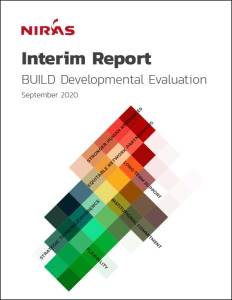BUILD Evaluation Interim Report
The challenge
Social justice organizations and networks are on the frontlines of accelerating and sustaining social change and building more just and equitable systems. They are fulcrums for creativity and dissent, beacons of stability, scaffolding for aspiring change makers, and connectors for social innovators. Yet, these organizations and networks often lack flexible funding or reserves to innovate, learn, take risks, and develop their work for the long term. The restrictive funding practices of many foundations contribute to this problem, preventing organizations from investing in strengthening areas that are vital to their impact—strategic vision and clarity, leadership, management systems, and financial stability, to name a few.
What we did
In 2015, the Ford Foundation launched its BUILD initiative as a 6-year, $1 billion dollar commitment to building institutions and networks. BUILD provides multi-year commitments, general operating support, and dedicated funding for institutional strengthening to 300 grantee partners to build more durable, more resilient, more networked, and more impactful organizations and networks to combat inequality. Convenings, technical assistance, evaluation, and strategic communications round out the BUILD model.
We are committed to learning from the BUILD model, both to improve our own practices and to share lessons with the broader field of philanthropy. In early 2018, we launched the BUILD evaluation with our external evaluation partner, NIRAS. We are taking a developmental approach, which entails the NIRAS team accompanying the Ford Foundation and our BUILD grantee partners on the journey, collecting quantitative and qualitative data, providing real-time feedback for learning and program adjustments, and tracking both emerging issues as well as longitudinal impacts. Ultimately, our hope is that the evaluation will contribute to more nuanced evidence and compelling stories about BUILD as a grantmaking approach, which will help shift the field of philanthropy toward providing more flexible, grantee-centered support.
NIRAS has completed the first phase of the BUILD evaluation, which shows several positive contributions of the BUILD program as outlined below. Still, there is more to learn and understand and the next and final phase of the developmental evaluation will continue through late 2021.
What we learned
- It’s the combined effect of the BUILD grant components, not one specific part, that helps BUILD grantees advance towards mission. The three aspects of a BUILD grant—long-term commitment, flexible funding, and institutional strengthening support—work together to help BUILD grantees be stronger, more resilient, and more effective. BUILD partners indicate that long-term funding provides “head space” for stability and planning, while flexibility allows them to adapt programs and strategy to dynamic environments. And dedicated funding for institutional strengthening, which is hard to come by, allows BUILD partners to invest in systems, operations, strategy, and leadership to be fit for purpose.
- BUILD works for a variety of institutions and networks of different sizes, structures, stages, places, and contexts. The evaluation explored structures and categories of multiple organizations and networks, such as younger, smaller emergent organizations; large, established organizations; and complex networks. It also examined particular contexts facing BUILD grantees, such as navigating a challenging political environment or undergoing a leadership transition. The emerging findings demonstrate that BUILD provides value across the board of categories and contexts. Interestingly, for organizations experiencing leadership transitions, the early finding is that BUILD seems to provide additional stability and flexibility for a smooth transition, as well as latitude for a new leader to provide strategic vision for an organization’s operations and culture, particularly for investing in DEI.
- BUILD grants can contribute to a ripple effect, where not only does the grantee become stronger and more effective, but so do its closest partners, members, and stakeholders. Networks and grassroots-organizing BUILD grantees report that BUILD has strengthened not only the recipient entity, but has also allowed for strengthening of members, chapters, and partners. Through the BUILD grant, network grantees report they have strengthened the individual nodes (members, chapters, etc.) of their networks, and importantly, the independent connections between and among the nodes. Grassroots-organizing partners reported that BUILD enabled them to smooth the ebbs and flows of organizing and supporting volunteers and temporary staff. They also reported that it enabled stronger partnerships with other grassroots organizers.
- Mission impact through BUILD is difficult to discern, but there are early indications that BUILD helps groups to create the conditions for mission success. Social justice is a long and non-linear pursuit, situated within a dynamic landscape, and subject to multiple independent variables. The interim evaluation report notes that it is too early to tell how BUILD contributes to an organization’s mission impact, but early evidence suggests that there is a relationship. At this time, grantees suggest that BUILD is contributing to greater strategic clarity, effectiveness, efficiency, and resilience that creates an enabling environment for short-term wins and positioning for long-term gains.
